More than 80 million Americans cast their ballots during the early voting period for the 2024 presidential election, and tens of millions more will head to the polls today. The race will almost assuredly be decided by the results in seven key swing states, and if 2020 is any guide, those results will come under an immense amount of scrutiny in the coming days and weeks.
Below, we have compiled a handy state-by-state primer detailing various election administration processes in the relevant battlegrounds, from regulations around absentee ballots to requirements for candidates looking to contest the results. Keep this page—and Chris Stirewalt’s latest newsletter—nearby while you’re watching the election returns (or our special three-hour Dispatch Live streaming coverage).
Arizona | Georgia | Michigan | Nevada | North Carolina | Pennsylvania | Wisconsin
Arizona
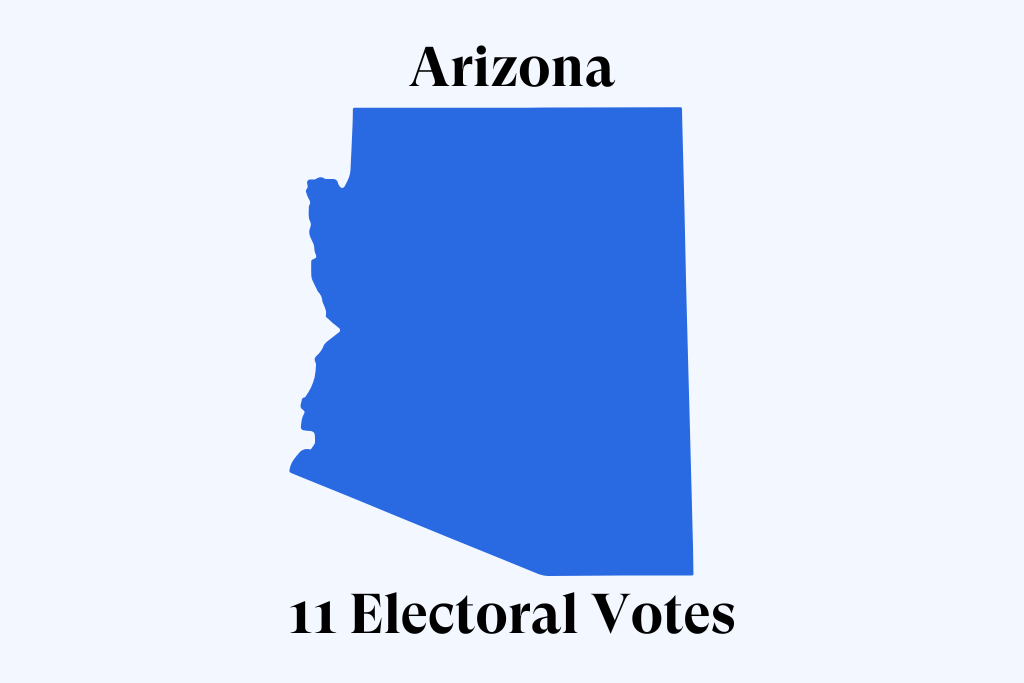
Results
2020 Election: Biden 49.4 percent, Trump 49.1 percent.
2024 RealClearPolling Average: Trump 49.1 percent, Harris 46.3 percent.
Partisan Affiliations:
- Governor: Katie Hobbs (D)
- Lieutenant Governor: N/A
- State Legislature:
- House: 31R-29D
- Senate: 16R-14D
- Secretary of State: Adrian Fontes (D)
- Supreme Court: Appointed, 7R-0D
Voting Timelines
Election Day polling hours: 6 a.m. to 7 p.m.
Early voting period: October 9 - November 1
Voter ID Laws
Photo ID is required for all voters, but voters with insufficient identification can submit a conditional provisional ballot. For the provisional ballot to be counted, the voter must present a valid ID to the county recorder by the end of the fifth business day following Election Day.
Absentee Rules
Who is eligible to vote absentee: All Arizona voters can choose to vote absentee with no excuse.
Deadline for when ballots need to be postmarked/received: Ballots must be received by 7 p.m. on Election Day to be counted.
Rules about ballot harvesting: Ballot harvesting is illegal and a Class 6 felony in Arizona. However, ballots can be collected and returned by family members, household members, or caregivers.
Rules about drop boxes: Arizona allows voters to return absentee ballots to unstaffed dropboxes.
Opening and counting absentee ballots: Early ballots can be counted immediately on receipt by county election officials.
How ballots are verified: Arizona compares the signature on an absentee ballot’s affidavit with signatures on file for the voter.
What type of ballots/voting machines are used: Arizona uses both hand-marked paper ballots and ballot-marking devices. Maricopa County uses systems manufactured by Dominion Voting Systems, Yavapai County uses systems manufactured by Unisyn, and all other counties use systems manufactured by ES&S.
Post-Election Processes and Deadlines
Ballot curing: State law requires election officials to make a reasonable effort to alert voters when ballot signatures cannot be verified. Voters have until 5 p.m. on the fifth day after Election Day to fix their ballot for federal elections.
Protesting/contesting: An elector contesting an Arizona state election must file a written statement in court within five days after completion of the canvass. The court must set a time to hear any contest no later than 10 days after a statement of contest is filed, and the court must make a judgment within five days of the hearing.
Certification: Each county’s board of supervisors must meet by November 21 to conduct the canvass. Upon completion, each board must immediately send the results to the secretary of state. On November 25, the secretary of state’s office will complete its own canvass, after which it will certify the election results.
Electors meeting: Electors will meet on December 17.
Recount Triggers
Automatic: A recount must be performed if the margin between the top two candidates is 0.5 percent or less of the total votes cast for the two candidates. The recount will start with a hand count of 5 percent of ballots submitted, and only if the margin is greater than the original count will all ballots be recounted.
Requested by campaigns: Only automatic recounts, no recount by request.
Legal Updates
Major rule changes since 2020: Arizona’s legislature in February 2024 passed House Bill 2785, which changed the canvassing deadlines for county government and the secretary of state so that the state could meet the certification deadline specified in the 2021 Electoral Count Reform Act.
Recently resolved or pending litigation: Litigation concerning a 2022 citizenship verification law passed by state Republicans is ongoing in Arizona. In August 2024, the Supreme Court ruled that Arizona could enforce proof of citizenship requirements for state voter registration forms while an appeal of a lower court decision progresses. However, the court did not allow enforcement of similar restrictions on federal voter registrations.
Georgia
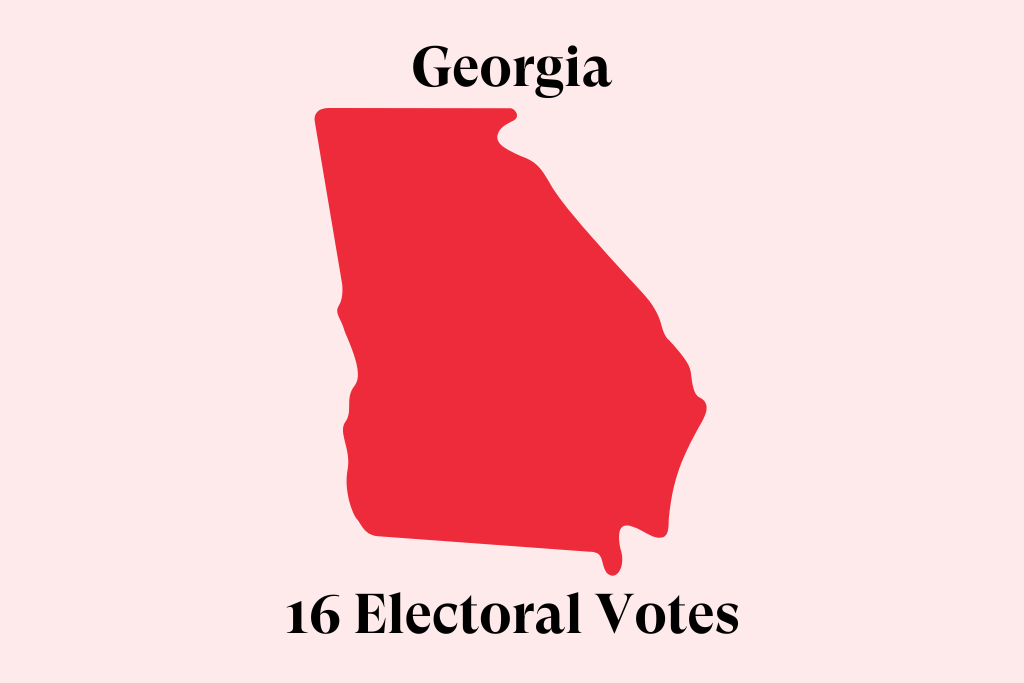
Results
2020 Election: Biden 49.5 percent, Trump 49.3 percent.
2024 RealClearPolling Average: Trump 49.1 percent, Harris 47.8 percent.
Partisan Affiliations:
- Governor: Brian Kemp (R)
- Lieutenant Governor: Burt Jones (R)
- State Legislature:
- House: 102R-78D
- Senate: 33R-23D
- Secretary of State: Brad Raffensperger (R)
- Supreme Court: Elected, nine nonpartisan seats
Voting Timelines
Election Day polling hours: 7 a.m. to 7 p.m.
Early voting period: October 15 to November 1.
Voter ID Laws
Photo identification is required when voting both in-person and via absentee ballot. Eligible forms of ID include government-issued IDs; driver’s licenses; student IDs from public colleges or universities; employee IDs for employees of local, state, or the federal government; U.S. passports; military photo IDs; and tribal photo IDs.
Absentee Rules
Who is eligible to vote absentee: Any registered voter may vote absentee in Georgia but must submit an application for an absentee ballot 11 to 78 days before Election Day.
Deadline for when ballots need to be postmarked/received: County election offices must receive completed absentee ballots by Election Day for them to count. They can be returned via mail, in-person drop-off to a county election office, or via a drop box.
Rules about ballot harvesting: A 2023 ruling by a federal court upheld Georgia’s ban on ballot harvesting, part of the state’s 2021 Election Integrity Act.
Rules about drop boxes: Absentee ballot drop boxes, first introduced in Georgia’s 2020 elections, were significantly restricted by the Election Integrity Act, although they still exist. Every county in Georgia must have a drop box, but no more than one per 100,000 voters. They also must be kept inside at early voting locations and be accessible only while the early voting location is open.
Opening and counting absentee ballots: Election workers started tabulating absentee and mail-in ballots three Mondays before Election Day, and are allowed to start counting on Election Day before polls close.
How ballots are verified: Absentee ballots are verified by a voter signature and must contain the voter’s driver’s license or state ID number. Election officials then confirm that the ballot was signed and check the ID number against a state database. Voters with rejected absentee ballots will be informed by phone, mail, and in writing. Georgia law stipulates, “The voter then has until 3 days after the election to submit voter ID in conjunction with an affidavit confirming the ballot was in fact theirs in order to cure the ballot.”
What type of ballots/voting machines are used: Georgia uses touchscreen voting machines (also known as ballot-marking devices) made by Dominion Voting Systems. After voters make their selections on the screen, the machine prints out a paper ballot for scanning and tabulation.
Post-Election Processes and Deadlines
Georgia law requires that county election superintendents, which are usually made up of multimember boards, certify all votes by 5 p.m. on the Monday following Election Day (this year that deadline rolls back one day due to the Veterans Day holiday on November 11). An October 15 ruling by a Fulton County Superior Court judge held that boards must certify votes even if they suspect fraud or error. The Georgia secretary of state must tabulate votes cast for presidential electors and present them to the governor by 5 p.m. on November 22. Candidates can file a petition to the state election board contesting the election for up to five days after election certification.
Recount Triggers
Automatic: There is no automatic trigger for a recount in Georgia.
Requested by campaigns: Candidates can request a recount if the margin of victory is less than or equal to 0.5 percent. They, or an election official, may also petition the secretary of state for a recount if there is suspicion of fraud or errors.
Legal Updates
Major rule changes since 2020: The Election Integrity Act of 2021 made a variety of changes to Georgia election law, including requiring photo ID for mail-in ballots, banning ballot harvesting, reducing the number of ballot drop boxes, and granting the state Legislature the power to appoint the state election board, which sets rules regarding elections and voting, investigates election procedures, and defines how to validate or invalidate ballots. It also shortened the timeframe in which people could request mail-in ballots, blocked officials from mailing absentee ballots to voters that were not requested, and banned people from handing out food or water to voters within 150 feet from polling locations and within 25 feet from voting lines.
Recently resolved or pending litigation: In October, a Fulton County Superior Court judge blocked the state election board’s September rule change requiring that ballots must be counted by hand by poll workers on Election Day. The judge ruled that the rule change was “too much, too late” and required more time for consideration on the merits. In 2023, a federal judge ruled that individuals could pass out food and water to voters as long as they were 150 feet away from a polling place.
Michigan
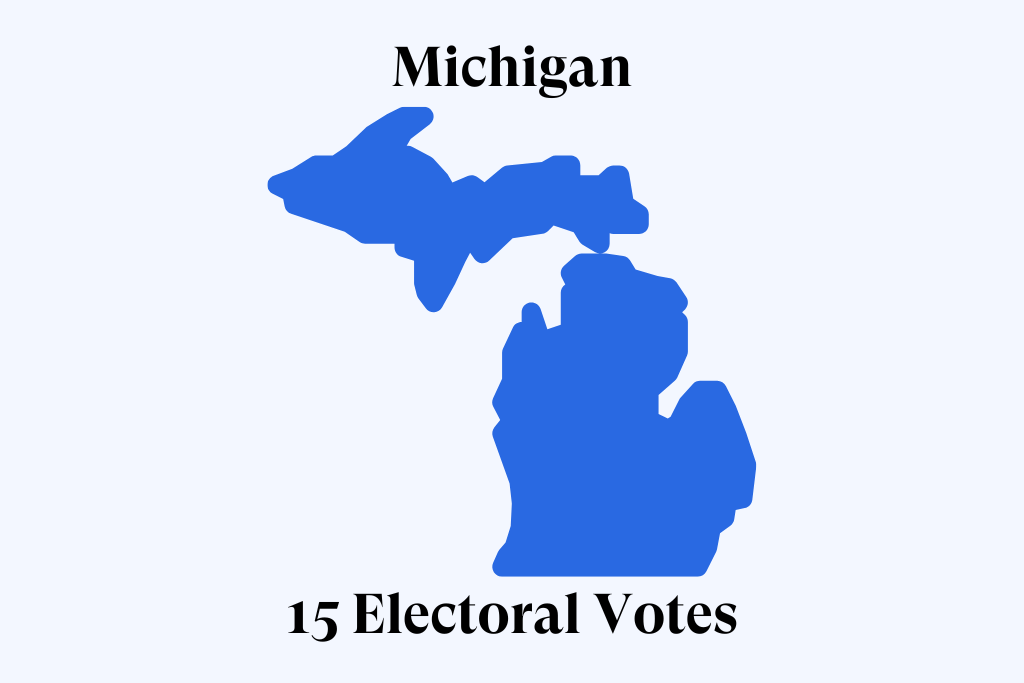
Results
2020 Election: Biden 50.6 percent, Trump 47.8 percent.
2024 RealClearPolling Average: Harris 48.3 percent, Trump 47.8 percent.
Partisan Affiliations:
- Governor: Gretchen Whitmer (D)
- Lieutenant Governor: Garlin Gilchrist II (D)
- State Legislature
- House: 56D-54R
- Senate: 20D-18R
- Secretary of State: Jocelyn Benson (D)
- Supreme Court: Elected, 4D-3R
Voting Timelines
Election Day polling hours: 7 a.m. to 8 p.m.
Early voting period: October 26 to November 3 (Detroit started October 19, and Canton started October 21)
Voter ID Laws
Voters without an I.D. can sign an affidavit to receive a ballot.
Absentee Rules
Who is eligible to vote absentee: Michigan has no-excuse absentee voting, so voters may request an absentee ballot for any reason.
Deadline for when ballots need to be postmarked/received: For elections officials to count them, ballots must be received by their local clerk’s office or put into a dropbox by 8 p.m. on Election Day—except for military and overseas ballots, which must be postmarked on or before November 5 and received within 6 days after Election Day.
Rules about ballot harvesting: There are a select few people who can return a voter’s absentee ballot: the voter, a person in the voter’s immediate family or household who has been asked to do so, a mail carrier acting in an official capacity, or an election official in the jurisdiction of the voter.
Rules about drop boxes: The state gives each jurisdiction one state-funded drop box. Locales with more than 15,000 registered voters must have one drop box for every 15,000 voters, and they must be available 24 hours a day starting 40 days before the election until Election Day at 8 p.m. The drop boxes must be in a “public and well-lit area” and secured so that ballots cannot be stolen and so that the box itself cannot be taken.
Opening and counting absentee ballots: Michigan’s rules for processing absentee ballots vary by municipality. Those with 5,000 or more residents may create an “absent voter counting board” to begin processing votes eight days before Election Day and do so between the hours of 7 a.m. and 8 p.m. Smaller cities and towns may tabulate their ballots starting the day before the election during the hours of 7 a.m. to 8 p.m. The smaller jurisdictions can also enter into agreements with other municipalities to form a combined absent voter counting board, which allows them to begin their preprocessing eight days before Election Day. However, this process never includes totaling the vote count.
How ballots are verified: Authorities use signature verification to affirm a voter’s identity.
What type of ballots/voting machines are used: Michigan uses paper ballots, which are run through tabulators, the brand of which varies by county.
Post-Election Processes and Deadlines
Ballot curing: If a voter’s ballot is rejected because of a faulty signature, he can return a cure form by the Friday after Election Day, or November 8.
Protesting/contesting: It would appear there’s none specified.
Certification: County boards of canvassers must certify their elections no later than two weeks after Election Day, i.e. by November 19. After that, the state board must certify the election by 20 days after the election, or November 25 this year.
Electors meeting: Electors convene on the first Tuesday after the second Wednesday in December, this year, December 17.
Recount Triggers
Automatic: With few exceptions, the state automatically conducts a recount if the difference between the first and second-place finishers for a statewide office is under 2,000 votes.
Requested by campaigns: Any candidate can request a recount.
Legal Updates
Major rule changes since 2020: There are several changes to Michigan voting rules this cycle, thanks in large part to a ballot referendum voters approved in 2022. In implementing the measure, the legislature passed several bills that, among the most notable changes, expanded early voting, allowed municipalities to start tabulating absentee ballots earlier, mandated the use of drop boxes with security measures, and allowed voters to apply for an absentee ballot only one time before being put on a permanent list.
Recently resolved or pending litigation: The Republican National Committee launched multiple lawsuits against Michigan Secretary of State Jocelyn Benson. After the two parties reached a settlement, Benson updated her guidelines to require that clerks mark on absentee ballot envelopes that they had verified a voter’s signature. Additionally, a judge ordered Benson days later to update her guidance to say that election workers “must” ensure that the number on an absentee ballot matches the number on the envelope that contains it. Previous guidance said a worker “should” verify the number. Later, however, the RNC suffered two losses in Michigan. First, a judge rejected a challenge to a state policy allowing spouses and children of people living overseas who last lived in Michigan to vote in the state, even if they themselves had never resided there. Next, a federal judge said a complaint from the committee, which alleged there were more registered voters than eligible Michiganders in the state, was unfounded.
Nevada
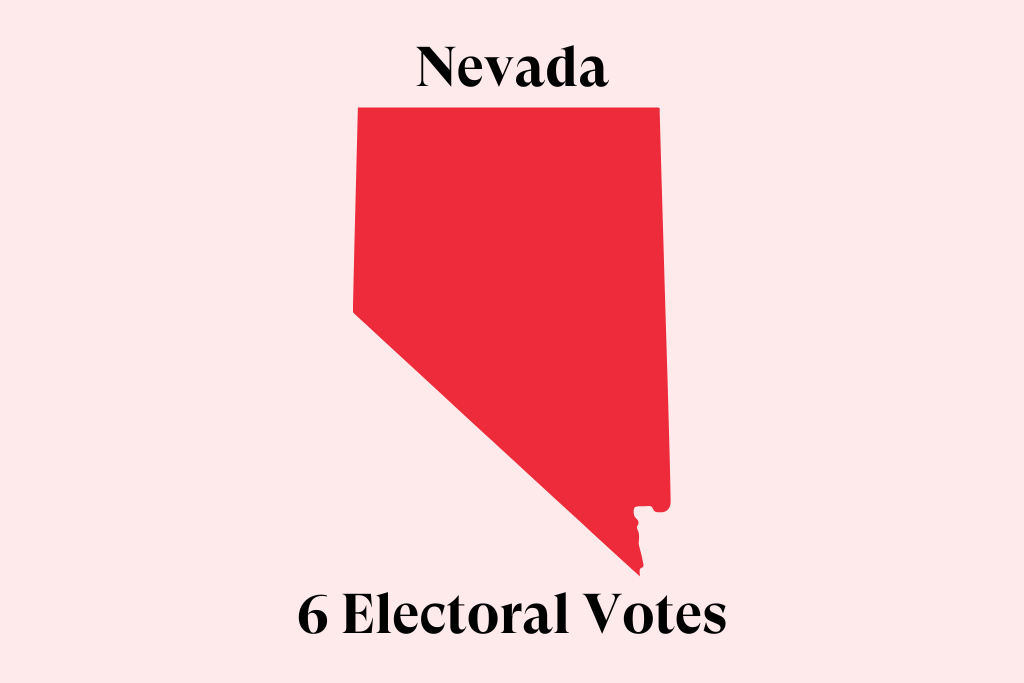
Results
2020 Election: Biden 50.1 percent, Trump 47.7 percent.
2024 RealClearPolling Average: Trump 48.2 percent, Harris 47.6 percent.
Partisan Affiliations:
- Governor: Joe Lombardo (R)
- Lieutenant Governor: Stavros Anthony (R)
- State Legislature:
- Assembly: 26D-14R (two vacancies)
- Senate: 13D-7R (one vacancy)
- Secretary of State: Francisco “Cisco” V. Aguilar (D)
- Supreme Court: Elected, seven nonpartisan justices. Three justices are running unopposed for reelection this cycle.
Voting Timelines
Election Day polling hours: 7 a.m. to 7 p.m.
Early voting period: October 19 to November 1
Voter ID Laws
Nevada voters are not required to provide an ID to cast a ballot, but they are required by state law to have their signature verified. Voters provide a signature to election officials at the polling site, which is verified against 1) the individual’s signature on their voter registration application or 2) any government-issued ID a voter brings. First-time voters in the state may need to present a voter ID if their registration information does not match records with the state DMV or federal Social Security Administration.
Absentee Rules
Who is eligible to vote absentee: Every Nevada registered voter is sent an absentee ballot in the mail provided they register at least 14 days before Election Day. Voters can vote in-person regardless of whether or not they are mailed a ballot. Automatic absentee ballot delivery was initially introduced temporarily during the COVID-19 pandemic, but the law was made permanent in 2021.
Deadline for when ballots need to be postmarked/received: Voters may submit their ballot at any drop box in their county or deliver it to their county clerk up until 7 p.m. on Election Day. Ballots must be sent on or before Election Day and received by the county clerk no later than 5 p.m. on November 9. If the date a ballot was mailed is not postmarked, but it was received by November 8, it is considered eligible and will be counted.
Rules about ballot harvesting: State law allows voters to have someone deliver their ballot for them, either in-person or via mail.
Rules about drop boxes: Ballot drop boxes are required to be posted at every available early voting and Election Day polling sites and open at least during the hours of the polling site. County clerks may also choose to place drop boxes at other locations within the city.
Opening and counting absentee ballots: Election workers may begin counting mail-in ballots as early as October 21, 15 days before Election Day, and must finish counting mail-in ballots no later than November 12, precisely one week after Election Day. Ballots dropped off at drop boxes are considered mail-in ballots.
How ballots are verified: Election officials verify signatures of mail-in ballots. Election workers manually verify ballot signatures or have an electronic ballot machine do so. Only voting machines that verify signatures by taking a digital image of the signatures are eligible in the process. Signatures rejected by a machine are manually reviewed. The county clerk has the final say in whether a ballot is rejected because of failed signature verification.
What type of ballots/voting machines are used: Nevada currently uses two voting machine model types from Dominion Voting Systems, and one model from Election Systems & Software.
Post-Election Processes and Deadlines
County commissioners are required to provide an abstract of the votes no later than November 15, 10 days after Election Day, which is then certified by the county clerk. On the fourth Tuesday of November, the Nevada secretary of state and justices of the state Supreme Court will meet and review the vote tallies. After they are approved, the governor “shall issue” certification of the election results and declare the winner of each race. Certification of the election results is required by state law and “must not be withheld,” regardless of any objections to the election and election tallies.
Recount Triggers
Automatic: There are no automatic recounts in Nevada.
Requested by campaigns: Any candidate or voter in the state can request a recount.
Similarly, every Nevada candidate and voter is also eligible to submit an election complaint, except for races electing federal congressional members. Races can be contested under certain circumstances, including wrongdoing from an election board member, inclusion of “illegal or improper” ballots, exclusion of “legal and proper” votes, evidence of illegal election wrongdoing from a candidate or campaign, or presence of electronic voting machine errors. Contests of election results are prioritized in state court above “all regular business of the court,” and heard between five and 10 days after the contest was filed. If the court finds a different person was the rightful winner of the race, they have the authority to nullify the election results certified by the governor.The court has no authority to certify a different election winner—even if they find that candidate to have received the most votes—but can only reject the results they ruled as improper.
Legal Updates
Major rule changes since 2020: Assembly Bill 321, a measure that made permanent the pandemic-induced provision to send each Nevada registered voter an absentee ballot and outlined the process for counting absentee ballots, was signed into law. In 2023, the state passed legislation that made certain actions against election workers—including harassment, threats of violence, and doxxing—a criminal felony, meaning offenders could face the possibility of prison time. In another bill passed in 2023, Nevada lawmakers extended confidentiality protections—previously granted to groups including state judges and victims of domestic violence—to election workers, local officials, and state prosecutors.
Nevada also introduced a centralized voter system, officially called the Voter Registration and Election Management Solution (VREMS), that tracks voter registrations and election results statewide. Before the adoption of VREMS was signed into law in 2023, voter management was determined at the county level.
Recently resolved or pending litigation: In June, the Trump campaign, the Republican National Committee, and the Nevada Republican Party sued the state of Nevada for its decision to require ballots that were received without a postmark to be counted if they arrive no later than three days after Election Day. According to the text of the law, ballots that arrive before the deadline must be counted even if the “date of the postmark cannot be determined.” A state judge ruled in favor of the state of Nevada in August, and on October 28 the state Supreme Court upheld the opinion.
North Carolina

Results
2020 Election: Trump 50.1 percent, Biden 48.7 percent.
2024 RealClearPolling Average: Trump 48.7 percent, Harris 47.5 percent.
Partisan Affiliations:
- Governor: Roy Cooper (D)
- Lieutenant Governor: Mark Robinson (R)
- State Legislature:
- House: 72R-48D
- Senate: 30R-20D
- Secretary of State: Elaine Marshall (D)
- Supreme Court: Elected, 5R-2D
Voting Timelines
Election Day polling hours: 6:30 a.m. - 7:30 p.m.
Early voting period: October 17 - November 2
Voter ID Laws
Photo ID is required to vote, but exemptions exist for voters with religious objections to being photographed, victims of natural disasters within 100 days of the election, and voters who have a “reasonable impediment” that prevents them from showing an ID. Voters who don’t meet the exemptions but cannot show ID may fill out an ID Exception Form and vote provisionally. These voters must present an acceptable ID at the county board of elections office by the close of business on November 14, the day before county boards of elections meet to authenticate election results.
Absentee Rules
Who is eligible to vote absentee: Any voter registered in North Carolina may vote using a mail-in absentee ballot. Absentee ballots should have been requested via an online portal or paper form by October 29.
Deadline for when ballots need to be postmarked/received: Ballots must be received by a voter’s county board of elections by 7:30 p.m. on Election Day to be counted.
Rules about ballot harvesting: Only a voter or their “near relative or legal guardian” may mail or hand-deliver an absentee ballot. If a person needs assistance to cast an absentee ballot, the sealed envelope can be taken by any individual directly to the closest U.S. mail depository or mailbox (including a personal mailbox). This person must also sign a Voter Assistant Certification on the backside of the envelope.
Rules about drop boxes: Ballot drop boxes are prohibited in North Carolina. Absentee ballots can only be returned by mail or in person. Military and overseas ballots may be received and submitted electronically using an online portal.
Opening and counting absentee ballots: The county board of elections can only begin counting absentee ballots on Election Day at a predetermined time between 2 and 5 p.m.
How ballots are verified: Absentee ballots require photocopies of photo ID, with the same exceptions as in-person voting. Request forms for ballots also require the voter’s date of birth and either a driver’s license number or the last four digits of the voter’s Social Security number.
What type of ballots/voting machines are used: All counties in North Carolina use either hand-marked paper ballots or ballot-marking devices that print votes on reviewable paper ballots. Approved voting systems are provided by three vendors: Electronic Systems and Software, Hart InterCivic, and Clear Ballot.
Post-Election Processes and Deadlines
Ballot curing: State law requires the county board of elections to notify voters of ballot defects and inform them of how to rectify the issue. Corrections must be made by 5 p.m. on the ninth day following Election Day. Specific curing procedures are determined by each county board.
Protesting/contesting: A protest against the conduct of the election must be filed in writing to a county board by a registered and eligible North Carolina voter or a candidate for nomination in the election. If the protest concerns vote counting or tabulation, the protest must be filed prior to the county board’s canvass meeting on November 15. If the protest states good cause for delay in filing, it may be filed until 5 p.m. on the second business day after the county board has completed its canvass. For any protests unrelated to vote counting or tabulation, the protest must be filed no later than 5 p.m. on the second business day after the county board has completed its canvass.
Protests are heard by the county board of elections, and decisions can be appealed to the state board of elections. The state board of elections may also consider protests on its own motion, intervene in protests pending before county boards, or “take any other action necessary to assure that an election is determined without taint of fraud or corruption and without irregularities that may have changed the result of an election.”
Certification: Issued by county boards six days after the completion of the canvass. Upon receipt of the certifications, the secretary of state will notify the governor.
Electors meeting: The governor will instruct electors to appear in the state capitol “at noon on the first Tuesday after the second Wednesday in December next after their election, at which time the electors shall meet and vote on behalf of the State for President and Vice-President of the United States.” This year’s meeting of electors will take place on December 17.
Recount Triggers
Requested by campaigns: A candidate has the right to demand a recount if the margin of victory is under 0.5 percent of the total votes cast
If that recount was done by machine, then a candidate can request a hand recount of 3 percent of precincts in each county selected at random. If the error rate in the sample precincts would be enough to change the results, the state will conduct a hand recount for all ballots cast.
Legal Updates
Major rule changes since 2020: A veto-proof Republican Legislature passed Senate Bill 747 in 2023, overriding Democratic Gov. Roy Cooper’s veto. The bill made various changes to state election law, including moving up the deadline for receipt of mail-in ballots and requiring 10 counties to run a pilot signature matching program on mail-in ballots. The bill also fixed a loophole that allowed some ballots attached to unverified registrations to be counted in 2020.
The 2024 election will also be the first general election in which the state’s law requiring photo ID to vote will be in effect. The law was initially passed in 2018, but was found unconstitutional by the state supreme court. In 2023, the court reversed its previous ruling.
Recently resolved or pending litigation: In August, the Republican National Committee and the North Carolina Republican Party sued the state board of elections and claimed it failed to collect required identification information for more than 225,000 people.. There are several other ongoing election cases in the state, including one related to absentee ballot envelope rules and another to overseas voting. However, none of these cases are likely to affect the 2024 race.
Pennsylvania
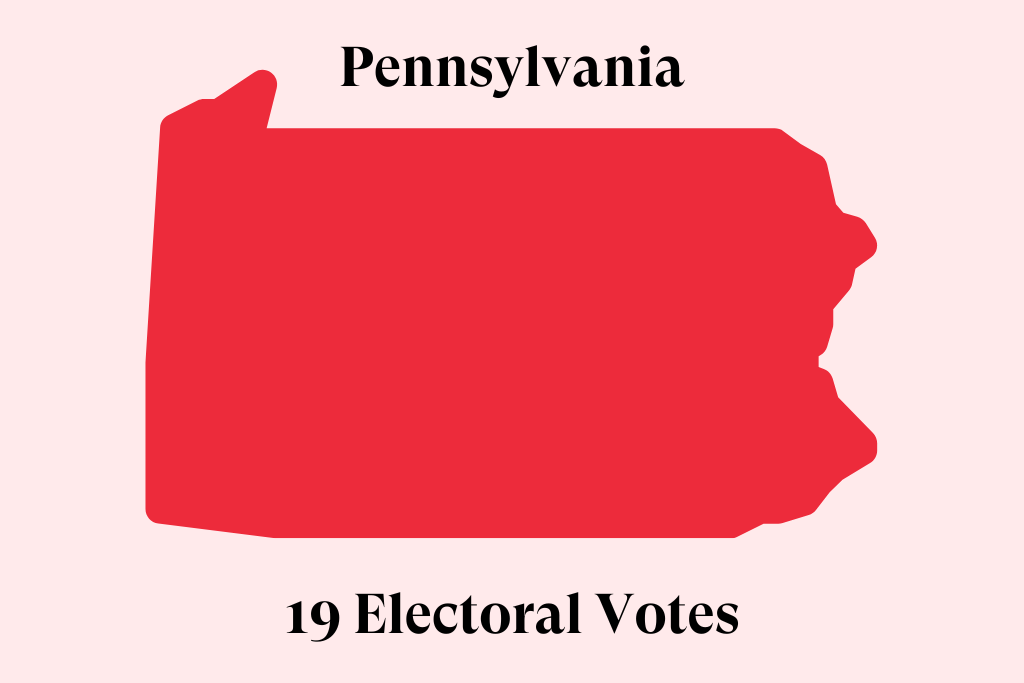
Results
2020 Election: Biden 50 percent, Trump 48.8 percent.
2024 RealClearPolling Average: Trump 48.5 percent, Harris 48.1 percent.
Partisan Affiliations:
- Governor: Josh Shapiro (D)
- Lieutenant Governor: Austin Davis (D)
- State Legislature:
- Senate: 28R-22D
- House: 102D-101R
- Secretary of State: Al Schmidt (R)
- Supreme Court: Elected, 5D-2R
Voting Timelines
Election Day polling hours: 7 a.m. to 8 p.m.
Early voting period: Voters had until October 29 to vote “in person by mail,” a system in which voters must request a mail-in ballot from their county elections office when ballots are available, receive it, then fill the ballot out and submit it there.
Voter ID laws
First-time voters and those voting in a new precinct require ID verification to vote, which includes driver's licenses, state or federal IDs, passports, student IDs, employee IDs, firearm permits, utility bills, bank statements, paychecks, or government checks. ID is not required for other voters.
Absentee Rules
Who is eligible to vote absentee: Any voter who is out of their municipality on Election Day, or has a disability or illness preventing them from voting in person, may apply for an absentee ballot. An absentee ballot application must have been received by October 29.
Deadline for when ballots need to be postmarked/received: Absentee ballots must be received by 8 p.m. on November 5. Military and overseas absentee ballots must be submitted for delivery no later than 11:59 p.m. November 4 and received by November 12.
Rules about ballot harvesting: Returning a ballot for someone else is illegal unless a voter’s disability prevents them from delivering a mail ballot. The voter must designate someone in writing to deliver the ballot.
Rules about drop boxes: Counties are allowed to provide drop boxes for the submission of absentee ballots.
How ballots are verified: Absentee ballots are verified by comparing the information on the ballot’s return envelope with the list of registered absentee voters on file. Signature verification is not required.
Opening and counting absentee ballots: Election officials are not allowed to open absentee and mail-in ballots until 7 a.m. on Election Day.
What type of ballots/voting machines are used: About 70 percent of Pennsylvania voters fill out a paper ballot by hand, which is then tabulated by a machine. Roughly 30 percent of voters use ballot marking devices, which print out a paper ballot that is then tabulated. More than half of the state’s counties use machines made by ES&S; others in use are made by Clear Ballot, Dominion, Unisyn, and Hart InterCivic.
Post-Election Processes/Deadlines
Ballot curing: There is no statewide ballot curing process in Pennsylvania and no state requirement for county boards to notify voters of their votes.
Protesting/contesting: Campaigns can file a complaint in the Court of Common Pleas contesting election results; other parties can submit a petition of at least 100 registered voters, of whom 20 must have signed affidavits.
Certification: County boards must send unofficial returns to the Secretary of State by 5 p.m. on November 12. The county board must then certify the returns within five days if no corrections (such as recounts) are necessary. If revisions must be made, results still must be certified by November 25. The governor then certifies the results no later than December 11.
Electors meeting: December 17.
Recount Triggers
Automatic: Recounts are triggered by a voting margin of 0.5 percent or less. Three voters in any given district may also request a recount in their precinct.
Legal Updates
Major rule changes since 2020: Pennsylvania has seen no major changes to elections laws since 2020, although there have been failed attempts to allow the pre-processing of mail-in ballots before Election Day and to count undated mail-in ballots.
Recently resolved or pending litigation: The Supreme Court declined to Republicans’ request to overturn a ruling by the Pennsylvania Supreme Court that allowed voters whose mail-in ballots were deemed invalid to file a provisional ballot in person on Election Day.
Wisconsin
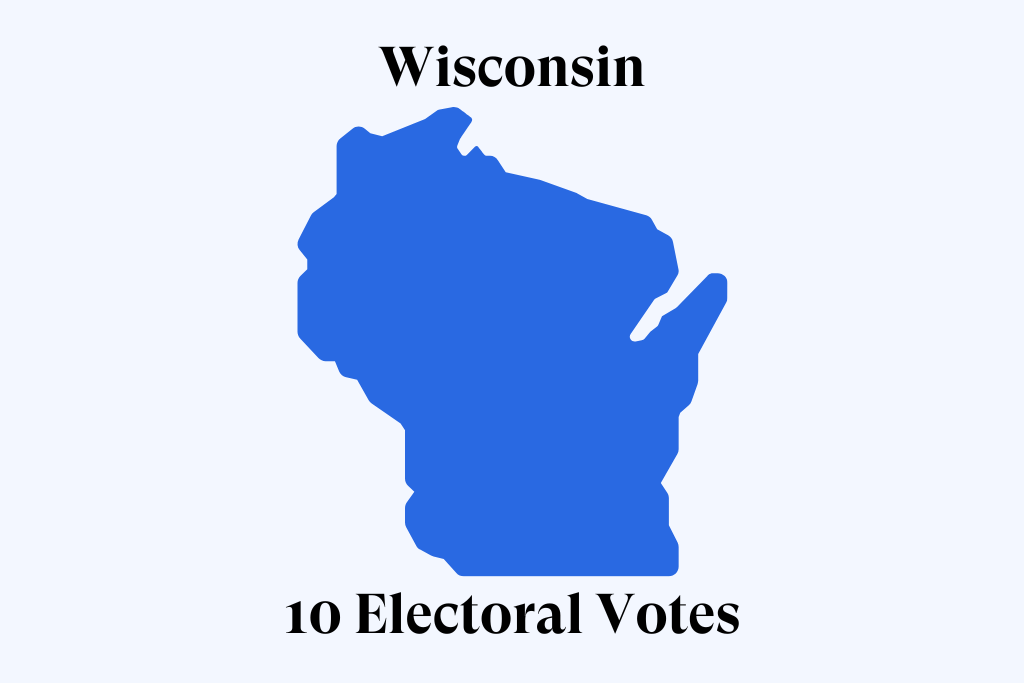
Results
2020 Election: Biden 49.6 percent, Trump 48.9 percent.
2024 RealClearPolling Average: Harris 48.6 percent, Trump 48.2 percent.
Partisan Affiliations:
- Governor: Tony Evers (D)
- Lieutenant Governor: Sara Rodriguez (D)
- State Legislature:
- Assembly: 64R-34D
- Senate: 22R-10D
- Secretary of State: Sarah Godlewski (D)
- Supreme Court: Nonpartisan, but 4-3 liberal
Voting Timelines
Election Day polling hours: 7 a.m. to 8 p.m.
Early voting period: In-person absentee voting started on October 22 and the deadline depends on locality, ending no later than November 3.
Voter ID Laws
Voters need ID to vote. If they do not have it, they can vote provisionally and bring their ID to the polling place by 8 p.m. Otherwise, they can vote provisionally and bring their ID to the municipal clerk in-person by 4 p.m. the Friday after Election Day.
Absentee Rules
Who is eligible to vote absentee: All registered voters in Wisconsin are eligible to vote absentee.
Deadline for when ballots need to be postmarked/received: Local clerks must receive ballots by 8 p.m. on Election Day.
Rules about ballot harvesting: Wisconsin law implies that only voters themselves can return the ballot, with exceptions for those in the hospital.
Rules about drop boxes: Drop boxes are legal due to a recent state Supreme Court ruling.
Opening and counting absentee ballots: All ballots are processed and counted on Election Day.
How ballots are verified: Wisconsin voters must provide a photo ID when they request an absentee ballot, and they must fill out their absentee ballots in the presence of a witness. The voter and the witness must sign it.
What type of ballots/voting machines are used: Counties can choose from a list of approved technologies, but most use electronic machines.
Post-Election Processes and Deadlines
Ballot curing: Wisconsin has no curing process.
Protesting/contesting: Wisconsin does not have a contest procedure.
Certification: County boards of canvassers must meet by the Tuesday after Election Day, November 12, and give their results by two weeks after the election, or November 19, to the state elections commission, which must perform its canvass by December 1.
Electors meeting: The state’s electors meet the first Monday after the second Wednesday in December, which this year is December 16.
Recount Triggers
Automatic: Wisconsin has no provision for automatic recounts.
Requested by campaigns: Campaigns may request recounts if the difference is 1 percent or less.
Legal Updates
Major rule changes since 2020: The state’s Republican-controlled legislature has attempted to enact changes, but Gov. Tony Evers has vetoed the bills they have passed. However, voters did approve two GOP-backed ballot measures in April. One banned the use of private funds in election administration—often referred to as Zuckerbucks—and the other mandated that only people designated by the state may administer Wisconsin elections.
Recently resolved or pending litigation: Conservatives had the majority of justices on the state’s Supreme Court in 2022, and it prohibited the use of ballot drop boxes that year. However, liberals took the majority in 2023, and the new court overturned that decision earlier this year, making the use of drop boxes legal.
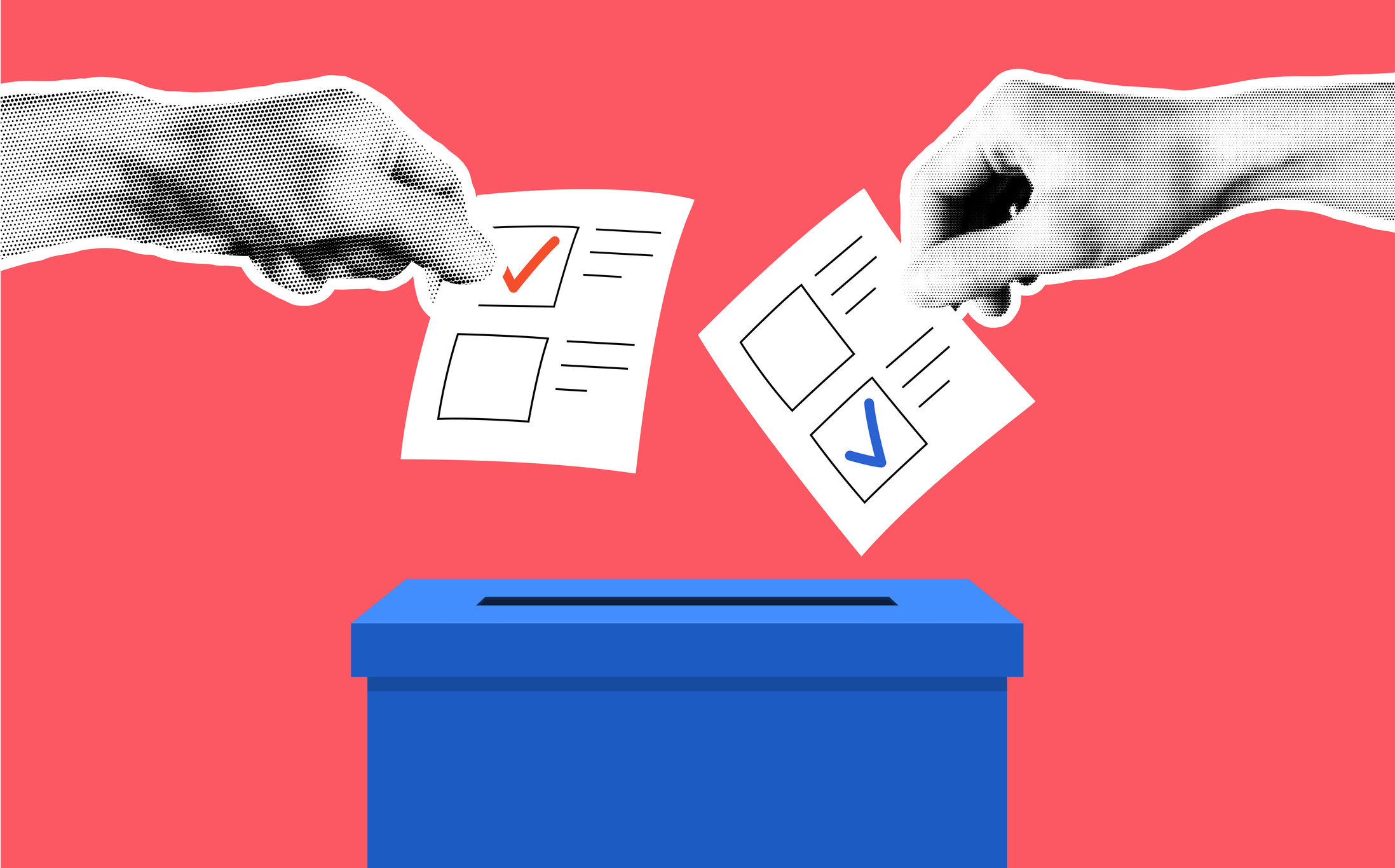








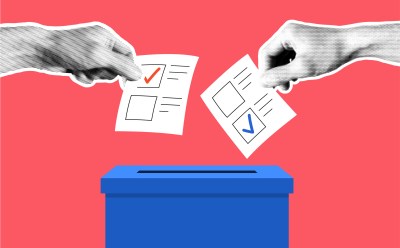
Please note that we at The Dispatch hold ourselves, our work, and our commenters to a higher standard than other places on the internet. We welcome comments that foster genuine debate or discussion—including comments critical of us or our work—but responses that include ad hominem attacks on fellow Dispatch members or are intended to stoke fear and anger may be moderated.
With your membership, you only have the ability to comment on The Morning Dispatch articles. Consider upgrading to join the conversation everywhere.